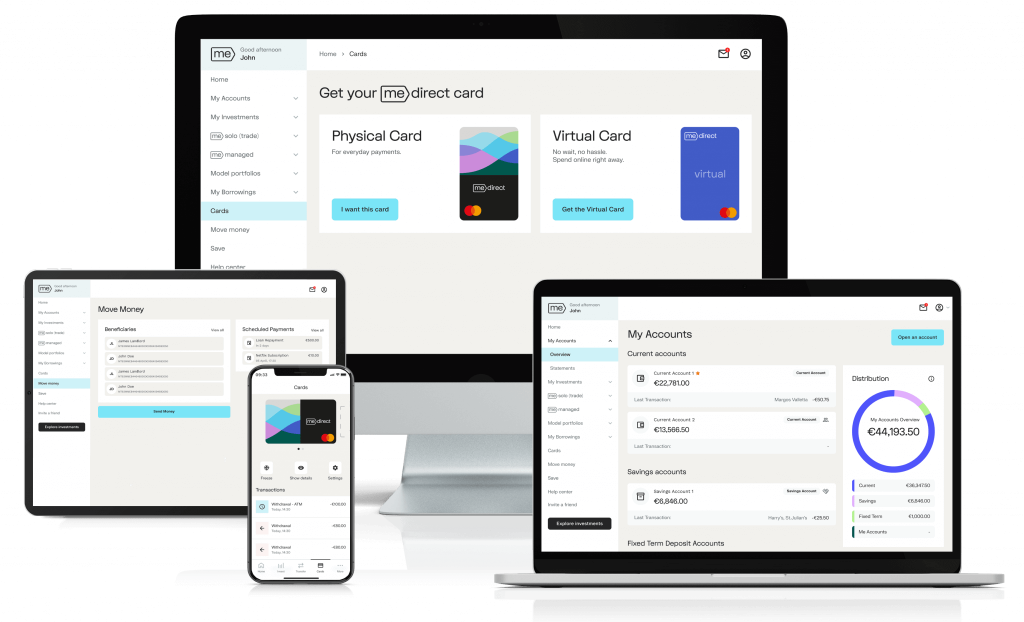 |
An article written by Ray Calleja: Head – Private Clients, MeDirect |
So far in our weekly articles we have looked at how a mutual fund has performed, how risky has it been, what is in the portfolio, who is managing it and how much does it cost. These are the factors that you need to consider whether you are choosing your first or your umpteenth fund.
However, if you are setting out to build up your investment portfolio of funds, there are some basic rules that you are recommended to follow. If you are considering your first equity fund you must see that it is well diversified. That means that the fund should hold a large number of stocks from a wide range of industries and sectors. The factsheets available for each fund available on the MeDirect website will tell you how many equities a fund owns as well as which sectors, they come from.
Most of the time funds which own many equities from many different sectors are generally more stable than those only holding shares in a few companies from a limited number of industry sectors.
This approach is also endorsed by our partners Morningstar, who advocate that you should own a core equity fund or two which form the foundation of your investment portfolio. They also state that investors are more successful when they buy a fund and hang on to it for many years. If you like and understand a fund’s approach then you are more likely to feel comfortable hanging on that fund, even during challenging and volatile times. A rule of thumb is that at least three-quarters of your equity holdings should be in so-called core funds. By core funds, we mean funds that are broadly diversified across sectors and individual equities. They are funds which do not put the bulk of their assets in small-companies but rather focus on large-company stocks. A simple guideline is to use the Morningstar style box, where you can look for large-growth, large-value or large blend funds. Large-value funds own equities which are undervalued; large-growth own shares in companies which have strong growth prospects and large-blend own companies with a combination of these two characteristics.
Knowing the difference between growth and value styles is important in building the investment strategy that is right for you. Combining different types of investments can also help to build a diversified portfolio.
Growth Equity funds invest in growth equities. These are equities in companies that are expected to grow at a faster rate when compared to the overall equity market. They are usually considered aggressive investments because they tend to have a relatively higher risk, along with relatively higher performance, compared to the main market indices.
Technology stocks, such as Netflix, Microsoft, Amazon and Facebook are good examples of what growth equity mutual fund managers buy for their funds. Growth funds pay little or no dividends so the return to the investor lies in the hope that there will be price appreciation of the underlying investment; whereas the return to the investor for value/income funds can be a combination of price appreciation and yield (dividends). An obvious indicator of a growth fund is often found with the word “growth” in their names.
In contrast Value Equity funds primarily invest in value equities, which are equities that an investor believes are selling at a discounted price in relation to earnings or other fundamental value measures. Value managers apply fundamental analysis by researching and analysing companies’ financial information to determine if the stock is under-valued and if it represents a ‘good value’ if purchased. As with the case of growth funds, value funds often include the word ‘value’ in their name. Equity funds that pay dividends are often considered value funds. This is why value funds are often referred to as ‘income funds.’ Investors may opt to take out the income or yield provided from such funds by choosing the income variant of the fund or they may also choose to invest in the accumulator versions whereby the managers add any income they receive from the underlying investments added to the existing fund. Therefore, value stock funds can also be purchased for the purpose of long-term growth, although the name or objective is not literally ‘growth’.
Growth and value are different styles of investing in equities. The growth style tends to have a higher degree of market risk with greater potential for higher returns compared to value investing. For a diversified portfolio, investors may consider a combination of growth and value. This is where blended funds come in, which are mutual funds that include a mix of both value and growth stocks and thus offer diversification among these popular styles in a single portfolio.
If you already own more than one equity fund do make sure that the funds do not significantly overlap one another. Many investors who select good funds may be unaware that they may be holding two or three funds which are essentially very similar funds. If the overlap among the holdings in companies that they own is very high, then there is no real diversification.
Looking at style drift is also important. If your intention is to be invested in US large caps your fund could actually be invested in, say, mid cap. You also need to look at how many equities they hold. There are large-cap funds that hold only 20 equities. There is more risk in that fund than one that holds 100 equities. Some funds may devote a large percentage of their assets to just one company, which also increases the risk and could therefore make returns unsustainable.
We next come to the million-dollar question. Are actively managed funds better or worse investments than the passively-managed index funds? Actively managed mutual funds employ portfolio managers who try to outsmart the market by over- and underweighting certain stocks or sectors.
Index Funds
Let us take a look at what Index Funds are. Here, the fund manager is buying the same stocks in exactly the same proportion as a given market benchmark. The objective of the fund is to follow the index and for this reason they are considered as passive investors.
Index funds do have many benefits. Most importantly, they tend to be low in cost, mainly because the fund managers are not actively managing their funds because they are replicating what the index does. Performance of index funds is fairly predictable as they usually provide the same return as their index less the management fee. If, for example, the fund index is the S&P 500 the fund will own large-blend equities and so it will always own the same type of equities because it is what the fund is tracking. This is in sharp contrast to managed mutual funds, where the manager analyses equities and tries to pick the best performing ones. As a result, the portfolio composition of equities in the fund can and will change from time to time.
With index funds, shareholders do not have to worry about the fund manager leaving the fund. If that fund manager does leave, the new one that comes in will still have to follow the same index as before.
Some of the most well-known indices include the S&P 500, the Dow Jones Industrial Average and the Nasdaq 100. Index funds are a popular strategy for ETFs to use. An ETF is a basket of securities that in most cases track an index. The funds that hold the securities are themselves listed like stocks. This means you can trade ETFs like stocks, buying and selling them on a stock exchange. Because an ETF tracks an index, the ETF performance will be very close to that of the index it tracks. ETFs are passive investment vehicles, and in complete contrast to active mutual funds, which aim to outperform a benchmark index. Exchange traded funds allow investors to earn the index return with lower costs than other investment products, which is their main attraction to them by investors. They are in fact cheaper than mutual funds.
Fund of Funds
Another category of funds is the Fund of Funds (FOFs), which are mutual funds that invest in other mutual funds rather than individual equities, bonds and other securities. Just as a regular mutual fund offers the skills of a professional manager, who assembles a portfolio of stocks or other securities, the manager of a FOF will select a portfolio of funds, managed by other managers. The goal of the FOFs is to achieve broad diversification and asset allocation with a variety of funds that are combined into one fund. FOFs often attract smaller investors who want a broader investment exposure while achieving less risk than by investing directly in each individual security.
A FOF allows you access to more funds than you might be able to afford on your own. However, it is worth noting that the FOF structure creates a double layer of costs. First, there are the expenses associated with running the FOF itself—management fees, administrative costs, etc. Second, there are the costs associated with the underlying funds—the same sorts of management fees, administrative costs, and so on. However, there are some FOFs, which eliminate the double-fee problem because they offer FOFs that invest only in their own funds. The fund house then waives the cost of the FOFs and you only pay the costs of the underlying funds.
Going back to the debate between active vs passive investing, the argument goes on unresolved. The choice between index funds and actively managed funds does not have to be either or. You can create a successful portfolio using either strategy or by combining the best of both worlds.
A joint study, earlier in the year, by Morningstar and Hartford Funds gave an insight on active vs passive investing. The white paper* examined the Morningstar Large Blend category because it is widely believed to be the most efficient category—the one that should invariably favour passive investing. Yet even this category showed the cyclical nature of active and passive performance. The same cyclicality is present in other investment categories such as mid-caps, small-caps, and global/international equities outside the US. A look at the last 35 years shows that active and passive investing are cyclical, trading places in terms of their outperformance over large periods of time.
When markets become volatile, the agility and flexibility of active management can become a competitive advantage. During the recent bull markets it was a good time to be in a low-cost, passive investment but when there is the kind of volatility like the one we have seen during the COVID-19 crisis, being in an actively managed fund will carry an advantage because the fund manager can choose to hold cash and not invest until the ‘right’ opportunity comes along. That is a flexibility that gives the active fund the advantage to wait until the market goes lower to reinvest.
As with any investment plan, it pays to consider the strengths and weaknesses of any given strategy. When considering an active manager, be sure to check the fund’s active share (which is a measure of the percentage of equity holdings in a manager’s portfolio that differs from the benchmark index), which will tell you whether it’s mostly mimicking an index or is truly positioned to add value over its benchmark.
The conclusions from the above-mentioned report provided more food for thought for us, the investors, namely that: the performance of active and passive management is cyclical—each style goes through extended periods of outperformance. When evaluating active and passive management, looking beyond recent performance and measuring active share is also important. As happened in December 2018, market corrections are inevitable and a common occurrence in equity markets over time. There have been 26 market corrections over the past 31 years, and active management outperformed passive management in 19 out of 26 corrections. During market corrections, the flexibility of active management allows for reducing exposure on the downside and ramping up exposure to capture alpha in the early stages of recovery.
* Whitepaper – The Cyclical Nature of Active & Passive Investing by HartfordFunds 02/2020
The above is for informative purposes only and should not be construed as an offer to sell or solicitation of an offer to subscribe for or purchase any investment. The information provided is subject to change without notice and does not constitute investment advice. MeDirect Bank (Malta) plc has based this document on information obtained from sources it believes to be reliable but which have not been independently verified and therefore does not provide any guarantees, representations or warranties.
MeDirect Bank (Malta) plc, company registration number C34125, is licensed by the Malta Financial Services Authority under the Banking Act (Cap. 371) and the Investment Services Act (Cap. 370).
The financial instruments discussed may not be suitable for all investors and investors must make their own informed decisions and seek their own advice regarding the appropriateness of investing in financial instruments or implementing strategies discussed herein.
If you invest in any of the products discussed you may lose some or all of the money you invest. The value of your investment may go down as well as up. A commission or sales fee may be charged at the time of the initial purchase for an investment and may be deducted from the invested amount therefore lowering the size of your investment. Any income you get from this investment may go down as well as up. This product may be affected by changes in currency exchange rate movements thereby affecting your investment return therefrom. The performance figures quoted refer to the past and past performance is not a guarantee of future performance or a reliable guide to future performance. Any decision to invest in a mutual fund should always be based upon the details contained in the Prospectus and Key Investor Information Document (KIID), which may be obtained from MeDirect Bank (Malta) plc.





